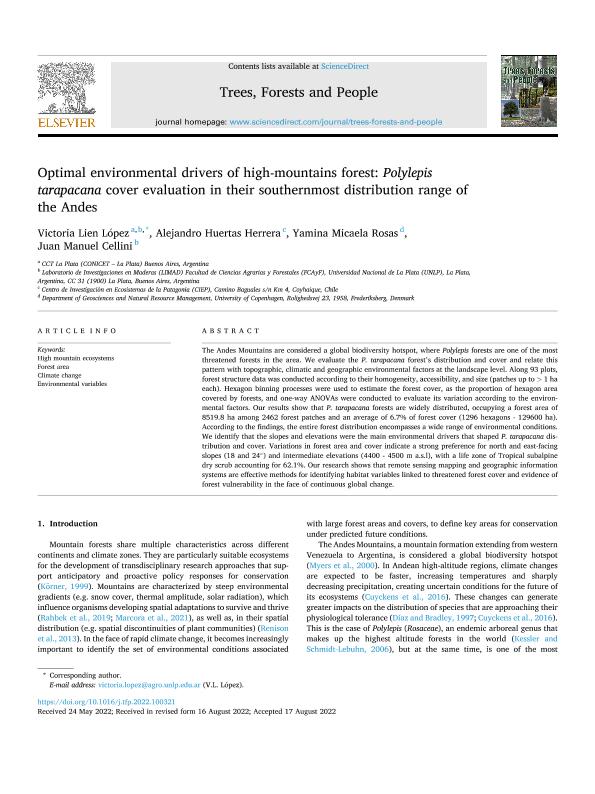Mostrar el registro sencillo del ítem
dc.contributor.author
Lopez, Victoria Lien

dc.contributor.author
Huertas Herrera, Alejandro

dc.contributor.author
Rosas, Yamina Micaela

dc.contributor.author
Cellini, Juan Manuel

dc.date.available
2023-12-22T13:16:10Z
dc.date.issued
2022-09
dc.identifier.citation
Lopez, Victoria Lien; Huertas Herrera, Alejandro; Rosas, Yamina Micaela; Cellini, Juan Manuel; Optimal environmental drivers of high-mountains forest: Polylepis tarapacana cover evaluation in their southernmost distribution range of the Andes; Elsevier; Trees, Forests and People; 9; 9-2022; 1-12
dc.identifier.issn
2666-7193
dc.identifier.uri
http://hdl.handle.net/11336/221239
dc.description.abstract
The Andes Mountains are considered a global biodiversity hotspot, where Polylepis forests are one of the most threatened forests in the area. We evaluate the P. tarapacana forest's distribution and cover and relate this pattern with topographic, climatic and geographic environmental factors at the landscape level. Along 93 plots, forest structure data was conducted according to their homogeneity, accessibility, and size (patches up to > 1 ha each). Hexagon binning processes were used to estimate the forest cover, as the proportion of hexagon area covered by forests, and one-way ANOVAs were conducted to evaluate its variation according to the environmental factors. Our results show that P. tarapacana forests are widely distributed, occupying a forest area of 8519.8 ha among 2462 forest patches and an average of 6.7% of forest cover (1296 hexagons - 129600 ha). According to the findings, the entire forest distribution encompasses a wide range of environmental conditions. We identify that the slopes and elevations were the main environmental drivers that shaped P. tarapacana distribution and cover. Variations in forest area and cover indicate a strong preference for north and east-facing slopes (18 and 24°) and intermediate elevations (4400 - 4500 m a.s.l), with a life zone of Tropical subalpine dry scrub accounting for 62.1%. Our research shows that remote sensing mapping and geographic information systems are effective methods for identifying habitat variables linked to threatened forest cover and evidence of forest vulnerability in the face of continuous global change.
dc.format
application/pdf
dc.language.iso
eng
dc.publisher
Elsevier

dc.rights
info:eu-repo/semantics/openAccess
dc.rights.uri
https://creativecommons.org/licenses/by-nc-nd/2.5/ar/
dc.subject
CLIMATE CHANGE
dc.subject
ENVIRONMENTAL VARIABLES
dc.subject
FOREST AREA
dc.subject
HIGH MOUNTAIN ECOSYSTEMS
dc.subject.classification
Silvicultura

dc.subject.classification
Agricultura, Silvicultura y Pesca

dc.subject.classification
CIENCIAS AGRÍCOLAS

dc.title
Optimal environmental drivers of high-mountains forest: Polylepis tarapacana cover evaluation in their southernmost distribution range of the Andes
dc.type
info:eu-repo/semantics/article
dc.type
info:ar-repo/semantics/artículo
dc.type
info:eu-repo/semantics/publishedVersion
dc.date.updated
2023-12-22T10:59:52Z
dc.journal.volume
9
dc.journal.pagination
1-12
dc.journal.pais
Irlanda

dc.journal.ciudad
Netherlands
dc.description.fil
Fil: Lopez, Victoria Lien. Consejo Nacional de Investigaciones Científicas y Técnicas; Argentina. Universidad Nacional de La Plata. Facultad de Ciencias Agrarias y Forestales; Argentina
dc.description.fil
Fil: Huertas Herrera, Alejandro. Consejo Nacional de Investigaciones Científicas y Técnicas; Argentina
dc.description.fil
Fil: Rosas, Yamina Micaela. Universidad de Copenhagen; Dinamarca. Consejo Nacional de Investigaciones Científicas y Técnicas; Argentina
dc.description.fil
Fil: Cellini, Juan Manuel. Universidad Nacional de La Plata. Facultad de Ciencias Agrarias y Forestales; Argentina
dc.journal.title
Trees, Forests and People
dc.relation.alternativeid
info:eu-repo/semantics/altIdentifier/url/https://doi.org/10.1016/j.tfp.2022.100321
dc.relation.alternativeid
info:eu-repo/semantics/altIdentifier/doi/http://dx.doi.org/10.1016/j.tfp.2022.100321
Archivos asociados
